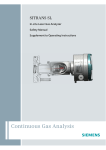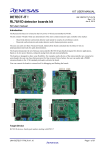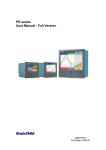Download Carbon Monoxide to Breathable Air Converter with Alarm System for
Transcript
Carbon Monoxide to Breathable Air Converter with
Alarm System for Automobile
By
Karen Kaye M. Alix
Patrick Wesley U. Chan
Christian Ramir P. Lazatin
Ma. Giovyline S. Rañoa
A Thesis Report Submitted to the School of EECE
in Partial Fulfillment of the Requirements for the Degree
Bachelor of Science in Computer Engineering
Mapúa Institute of Technology
June 2013
ii
ACKNOWLEDGEMENT
First and foremost the researchers would like to thank the God Almighty for giving us
wisdom and guidance in the completion of this thesis report.
This project would not have been possible without the support of many people. The
group wishes to express their gratitude to their thesis instructors, Prof. Ayra G. Panganiban
and Prof. Voltaire B. De Leon, who were unselfishly helpful and offered invaluable
assistance, support and guidance.
We also extend our special thanks to our adviser, Engr. Rafael G. Maramba, whose
encouragement, guidance and support from the preliminary to the concluding level enabled
us to develop an understanding of the subject.
Finally, we would like to thank our parents and siblings for supporting, providing
financial means and encouraging us to finish this project.
iii
TABLE OF CONTENTS
TITLE PAGE
i
APPROVAL PAGE
ii
ACKNOWLEDGEMENT
iii
TABLE OF CONTENTS
iv
LIST OF TABLES
vi
LIST OF FIGURES
vii
ABSTRACT
viii
Chapter 1:
INTRODUCTION
1
Chapter 2:
REVIEW OF LITERATURE
4
Carbon Monoxide
Carbon Monoxide Poisoning
Carbon Monoxide Reaction
Physiological Effects of Carbon Monoxide
Carbon Monoxide Statistics
Carbon Monoxide on the Car
Carbon Monoxide to Carbon Dioxide
Soda Lime
Carbon Monoxide Sensors
Electrochemical Sensors
Chapter 3:
4
5
5
7
8
10
10
12
14
14
CARBON MONOXIDE TO BREATHABLE AIR CONVERTER WITH
ALARM SYSTEM FOR AUTOMOBILE
16
Abstract
Introduction
Methodology
Hardware and General Preconditions
Software and General Preconditions
System Flow
Tolerable Level of CO
Devices and Equipment
Test Environment
16
16
19
19
22
22
25
28
28
iv
Results and Discussion
Statistical Test
Conclusion
29
29
32
Chapter 4:
CONCLUSION
34
Chapter 5:
RECOMMENDATION
35
REFERENCES
36
APPENDICES
37
Appendix A. Operation’s Manual
Appendix B. Pictures of Prototype
Appendix C. Program Listing
Appendix D. Data Sheets
Appendix E. Schematic Diagram of ATMega 168 Arduino
Appendix F. PCB Layouts
Appendix G. Statistical Computations
Appendix H. List of Materials
v
37
40
43
44
45
46
48
51
LIST OF TABLES
Table 1: Physical Properties of Carbon Monoxide
6
Table 2: Incompatibility of Materials
6
Table 3: Physiological Effects of CO poisoning
8
Table 4: Unintentional, non-fire-related deaths from carbon monoxide (CO) poisoning
9
in United States of America from 1999 to 2004
Table 5: Comparison of carbon monoxide detection technologies
14
Table 6: Recommended National Ambient Air Quality Objectives
25
Table 7: Trails involved on CO Concentration Pumped inside the Test Environment
29
Table 8: Trails Involved on CO Concentration Before and After Conversion
31
Table 9: Statistical Test on CO Concentration Before and After Conversion
31
vi
LIST OF FIGURES
Figure 1: Chemical reaction inside a 3-way catalytic converter
11
Figure 2: Chemical reaction of Soda Lime
12
Figure 3: How an Absorber Works
13
Figure 4: Typical Electrochemical Sensor Setup
15
Figure 5: Block Diagram of the Carbon Monoxide to Breathable Air Converter with
19
Alarm System for Automobile
Figure 6: Carbon Monoxide Monitoring System Main Circuit Schematic Diagram
20
Figure 7: Carbon Monoxide with Electrochemical Sensor Circuit Schematic Diagram
21
Figure 8: LCD Connection Circuit Schematic Diagram
21
Figure 9: Flowchart of the Carbon Monoxide Monitoring System
23
Figure 10: Flowchart of the Conversion Process
24
Figure 11: Recommended National Ambient Air Quality Objectives for Carbon
27
Monoxide and Predicted COHb Levels
Figure 12: Graph of CO Concentration Initial and CO Concentration Final
vii
32
ABSTRACT
Carbon monoxide (CO) gas is a compound produced by incomplete combustion of various
carbon-based fuels and substances. The slow accumulation of this poisonous gas can cause
headaches, nausea, vomiting, vertigo and confusion which are harmful for passengers' safety
and environmental protection. The purpose of this study was to develop a carbon monoxide
monitoring system for automobiles. The system includes a carbon monoxide detector which
is capable of measuring concentration of the gas when it reaches the predetermined levels;
the alarm system would notify the passenger/s and also the nearby people, at the same time it
would prevent the hazardous gas to spread inside the vehicle. As a way for the system to save
the passenger, the device will activate an exhaust fan connected inside the vehicle then it
would be directed to a modified catalytic converter to release the trapped gas passing through
the chemical reaction incorporating the soda lime for the soda lime air purification process.
Keywords: carbon monoxide monitoring system, catalytic converter, soda lime, alarm
system, air purification process
viii
Chapter 1
INTRODUCTION
Carbonous oxide or commonly known as carbon monoxide (CO) is a colorless,
odorless and tasteless gas that is fractionally lighter than air. It is a by-product of incomplete
combustion of fossil fuels, such as those combustion fumes made by cars and trucks, lamps,
stoves, gas ranges and heating systems. The carbon monoxide from these fumes can
accumulate in places, as a result of poor installation, poor maintenance, failure or damage of
an appliance in service, when the fuel is not burned properly, or when rooms are poorly
ventilated and don’t have a good flow of fresh air for the CO to escape. These results can
make the CO easily rise to potentially lethal and poisonous health risk. Since carbon
monoxide is colorless, odorless, tasteless and initially non-irritating, it becomes very difficult
for people to detect. Exposures to this toxic gas may lead to symptoms of mild acute
poisoning including confusion, vertigo, headaches, dizziness and flu-like effects; larger
exposures can lead to significant toxicity of the central nervous system and heart, and even
death. Carbon monoxide can also have severe effects on the fetus of a pregnant woman.
Prolonged exposure to low levels of carbon monoxide can lead to depression, confusion, and
memory loss.
CO, one of the major causes of respiratory disease, is also addressed as the “Silent
Killer”. It is the leading cause of accidental poisoning deaths in America. The US Center for
Disease Control estimates that carbon monoxide poisoning claims nearly 500 lives, and
causes more than 15,000 visits to hospital emergency departments annually.
1
Nowadays, carbon monoxide monitoring and alert systems are commercially
available in the market. Most of these devices are installed at home/buildings and are also
able to detect other dangerous gases in air while other systems are used in the mining
industry. Although there are many variations of the carbon monoxide system, almost all of
these are designed for buildings and home use only to detect the build up of poisonous gas in
the air and notify the people inside.
This study aims to develop a system with proper application of system-connected
carbon monoxide detectors that can monitor carbon monoxide concentration inside
automobiles and convert this harmful gas into breathable air. The specific objectives of this
study are to:
a) Integrate a catalytic converter with the use of soda lime.
b) Convert carbon monoxide into a breathable gas with implementation of
ATMega168 microprocessor for the system’s operation.
The study would significantly impart endeavor in assuring the health and safety of
both the people and the environment. Since carbon monoxide poisoning and air pollution is a
universal problem that the world is facing, this study would definitely contribute to the
decrease of the cause of respiratory diseases and also the reduction of the emission of air
pollutants in the environment. The study would also provide additional information by
proposing a better way of detecting the amount of carbon monoxide entering the vehicle that
possessed significant performance. Lastly, this research will be a helpful reference for other
related studies in the future.
2
The study entitled “Carbon Monoxide to Breathable Air Converter with Alarm
System for Automobile” deals with the selected automobile such as cars and vans. The
separation of the power supply unit of device from the vehicle’s power supply which is
tapped to the automobile’s battery makes it more reliable in terms of performing the
monitoring and releasing of the toxic gas, while the soda lime air purification process relies
on the power of the vehicle since it requires the modified catalytic converter to function
together with vehicle’s power supply. The device is dependent on the amount of soda lime
for the air purification process. The soda lime air purification process would take place if the
quantity of carbon monoxide inside the automobile reaches the standard amount, however if
the quantity is less than the standard, the system would remain idle.
3
Chapter 2
REVIEW OF RELATED LITERATURE
According to one of the Philippines’ news site, Inquirer.net, last July 5, 2010, a
teenage couple was found dead inside a car for the sole reason of carbon monoxide
poisoning. Investigators said the victims died of carbon monoxide suffocation after they
inhaled the exhaust fumes coming from the car. It was told that the moment the couple was
found dead; the car’s engine and air-conditioning were running. Chief Inspector Benjamin
Elenzano Jr. of the Quezon City Police District’s homicide section said that, “because of the
enclosed space of the garage and the fact that the car exhaust was facing a wall, the carbon
monoxide accumulated and seeped into the vehicle.”
Carbon Monoxide
Carbon monoxide (CO), also called carbonous oxide, is a colorless, odorless, and
tasteless gas that is slightly lighter than air. Carbon monoxide is formed by the incomplete
combustion of materials containing carbon and can be produced by virtually anything that
burns. However, it is short lived and spatially variable in the atmosphere, since it combines
with oxygen to form carbon dioxide and ozone.
It is a by-product of combustion, present whenever fuel is burned without enough air
(oxygen). It is commonly produced by home appliances such as gas or oil furnaces, gas
refrigerators, gas clothes dryers, gas ranges, gas water heaters, fireplaces, charcoal grills, and
wood burning stoves. Fumes from automobiles and gas-powered lawn mowers may also
contain carbon monoxide and can enter a home through walls or doorways if an engine is left
4
running in an attached garage. Other sources include industrial processes, cigars, smoldering
fires, etc.
Carbon Monoxide Poisoning
Carbon monoxide can be toxic to humans and animals when encountered in higher
concentrations, although it is also produced in normal animal metabolism in low quantities,
and is thought to have some normal biological functions. When you inhale carbon monoxide,
it can cause brain damage, suffocation or death. Because you cannot see, smell or taste this
deadly gas, poisoning can happen to anyone, anytime, anywhere. Everyone is at risk but
pregnant women, young children, senior citizens and people with heart and lung problems
are at greater risk. If your home is well sealed or not well ventilated, the levels of carbon
monoxide in the air may easily rise to deadly levels.
Carbon Monoxide Reaction
Carbon monoxide is flammable. Mixtures of carbon monoxide and air in the
flammable range will ignite if a flame or a spark is present. Flammable mixtures containing
carbon monoxide and other gases can be ignited easily by heated surfaces, open flames and
even by the burning tip of a cigarette. The serious nature of the flammability hazard is
reflected in the extensive flammable range of carbon monoxide in air (see Table 1 on page
6).
5
Table 1: Physical Properties of Carbon Monoxide
Physical Properties
Melting (freezing point)
Boiling Point (normal atmospheric pressure)
Vapor Density (air =1)
Flammability
Flammable Range (in air by volume)
Auto-ignition Temperature
-205°C
-192°C
0.9678
12.5 to 74%
610°C
-337°F
-313°F
1130°F
Courtesy of Industrial Accident Prevention Association 2008
Carbon monoxide is chemically reactive at temperatures over 90 °C. This reactivity
and chemical incompatibility can be of great concern in laboratories and process operations
where compressed carbon monoxide is present (see Table 2).
Table 2: Incompatibility of Materials
Materials to avoid
Metal oxides (e.g. iron oxide, nickel oxide) – reduced to lower metal oxides, metal or
metal carbides at elevated temperatures.
Some heavy metals (e.g. nickel, iron, chromium) – formation of explosive metal
carbonyls.
Alkali and alkaline earth metals (e.g. sodium, potassium, magnesium) – react to
produce salts.
Aluminum powder – ignition can occur.
Iodine heptafluoride – ignition can occur.
Sulfur – carbon monoxide reacts slowly with the liquid and rapidly with the vapor to
give carbonyl sulfide.
Chlorine – can form phosgene in the presence of light or a charcoal catalyst.
Bromine – can form carbonyl bromide in the presence of light or a charcoal catalyst.
Bromine
trifluoride,
bromine
pentafluoride,
chlorine
dioxide
or
peroodisulfuryldifluoride –react explosively.
Oxidizing materials – increased risk of fire and explosion.
Courtesy of Industrial Accident Prevention Association 2008
6
Physiological Effects of Carbon Monoxide
Most of the time, when there is poisoning of carbon monoxide on a person’s vital
system, symptoms are likely to be compared equally to common illnesses including tiredness,
headaches, dizziness, nausea or vomiting, and shortness of breath. The skin may also turn
pink or red in response to rising blood pressure.
The amount of CO which the blood absorbs depends on two things: how much CO is
in the air and the time of the exposure. Table 3 on the next page shows the different effects of
CO poisoning on humans based on the amount of CO in air and the length of exposure.
Adverse effects of CO on humans are reduced by periods of breathing fresh air. The degree
of recovery depends on the number and length of those periods.
Other factors that determine the effect carbon monoxide has on the body are:
o Age
o Fetuses (Maternal cigarette smoking is a major source of exposure.)
o Infants
o Older adults
o Individual susceptibility
o Smoker versus non-smoker (smokers have higher levels of carbon monoxide in their
blood and may experience harmful effects at lower concentrations)
o Gender: death rates higher in males
o Blood, heart, or lung conditions
7
Table 3: Physiological Effects of CO poisoning
Parts per Million
Time of Exposure
50
Response
Threshold limit, no apparent
toxic symptoms
No symptoms for long
periods
100
Several Hours
200
2-3 hours
Possible headache
400
1-2 hours
Frontal headache and nausea
800
45 minutes
800
2 hours
1600
20 minutes
1600
2 hours
3200
5-10 minutes
Headache and dizziness
3200
10-15 minutes
Unconsciousness and
possible death
6400
1-2 minutes
Headache and dizziness
6400
0-15 minutes
Unconsciousness and
possible death
12800
Immediate
Unconsciousness
12800
1-3 minutes
Danger of death
Headache, dizziness and
nausea
Collapse and possible
unconsciousness
Headache, dizziness and
nausea
Collapse, unconsciousness,
possible death
Courtesy ofhttp://www.carbon monoxide.ie/htm/poisoning.htm
Carbon Monoxide Statistics
Unintentional CO exposure accounts for an estimated 15,000 emergency department
visits and 500 unintentional deaths in the United States each year. The most recent state-level
estimates of CO-related deaths were described in 1991 for the years 1979-1988. Using the
most recent mortality data available, this report updates national and state-specific
8
unintentional, non-fire-related CO mortality rates and describes the demographic, seasonal,
and geographic patterns for 1999-2004 (see Table 4). During this period, an average of 439
persons died annually from unintentional, non-fire-related CO poisoning, and the national
average annual death rate was 1.5 per million persons. However, rates varied by demographic
subgroup, month of the year, and state. Rates were highest among adults aged >65 years,
men, non-Hispanic whites, and non-Hispanic blacks. The average number of deaths was
highest during January.
Table 4: Unintentional, non-fire-related deaths from carbon monoxide (CO) poisoning, in
United States of America from 1999 to 2004
Courtesy of http://www.cdc.gov/mmwr/preview/mmwrhtml/mm5733a2.htm
9
Carbon Monoxide on the Car
Motorists have expressed great concern over the recent incidents of deaths inside
automobiles. During the past years, a number of people have been found dead inside their
cars. The culprit is a silent but lethal gas known as carbon monoxide (CO).
Emissions of CO from vehicles are caused by defective exhaust system, defective
emission system, and poorly tuned engine. According to Greg Valdepenas, a chief mechanic,
a leak in the exhaust system allows the escape of CO before it is converted to nontoxic
carbon dioxide (CO,) in the catalytic converter. The leaking CO can enter through the holes
inside the car or open windows or doors. Old and dirty vehicles emit the highest
concentrations of CO and can leave a cloud of CO whenever it is used. Running through the
plume can cause health hazard to people. Smoke belching vehicles also contribute to CO
emission, he added.
Carbon Monoxide to Carbon Dioxide
A catalytic converter is a device incorporated into the exhaust system of an
automobile that reduces the amount of pollutants in the automobile's exhaust gases. The
catalytic converter is used to complete the oxidation process for hydrocarbon (HC) and
carbon monoxide (CO), in addition to reducing oxides of nitrogen (NO) back to simple
nitrogen and carbon dioxide. Toyota Motor Sales, U.S.A., Inc. makes use of a modern
catalytic converter also known as a three-way catalytic converter; the reason for this is that
the “3-way” refers to the 3 harmful compounds that it helps reduce (HC, CO & NO). The
basic materials of the three-way catalytic converter are platinum (Pt), rhodium (Rh) and
palladium (Pd), and a thin coat of their mixture is applied onto a honeycomb or porous
ceramic (carrier). Platinum and palladium are the oxidizing catalysts for HC and CO;
10
Rhodium is the reducing catalyst for NOx while Cerium promotes oxygen storage to improve
oxidation efficiency.
Courtesy of Toyota Motor
Sales, USA, Inc.
Figure 1: Chemical reaction inside a 3-way catalytic converter
Figure 1 shows the reaction of oxidation and reduction inside the 3-way catalytic converter.
As engine exhaust gases flow through the converter passageways, they contact the coated
surface which initiates the catalytic process. As exhaust and catalyst temperatures rise, the
following reaction occurs:
o Oxides of nitrogen (
(
are reduced into simple nitrogen (
) and carbon dioxide
)
o Hydrocarbons (HC) and carbon monoxide (CO) are oxidized to create water (
and carbon dioxide (
)
The Combustion Process
As stated by the U.S. Environmental Protection Agency Office of Mobile Sources,
gasoline and diesel fuels are mixtures of hydrocarbons, compounds which contain hydrogen
and carbon atoms. In a “perfect” engine, oxygen in the air would convert all the hydrogen in
11
the fuel to water and all the carbon in the fuel to carbon dioxide. Nitrogen in the air would
remain unaffected. In reality, the combustion process cannot be “perfect,” and automotive
engines emit several types of pollutants.
Perfect Combustion
FUEL (hydrocarbons) + AIR (oxygen and nitrogen)
CARBON DIOXIDE + water + unaffected nitrogen
Typical Engine Combustion
FUEL + AIR UNBURNED HYDROCARBONS + NITROGEN OXIDES + CARBON
MONOXIDE + CARBON DIOXIDE + water
Soda Lime
According to a technical article by Molecular Products Ltd. company entitled “An
Introduction to Sofnolime”, soda lime is an absorbent used for removal of carbon dioxide
mainly from breathable gases, in medical, military and safety applications. Sofnolime is
Molecular Products' brand name for soda lime. The gas is passed through the absorber and
the CO2 is removed by a water mediated base catalysed chemical reaction (Figure 2),
converting the CO2 to calcium carbonate and H2O which is retained within the absorber. The
strong base, NaOH, is not used up but acts as a catalyst.
Courtesy of Molecular Products Ltd
Figure 2: Chemical reaction of Soda Lime
12
As shown in Figure 3, the absorber will have a finite life based on the quantity of
Sofnolime contained and the level of CO2 within the treated gas. The absorber will remove
all of the CO2 (if appropriately sized for the application) and once the Sofnolime is
consumed, CO2 breakthrough will occur and the CO2 level in the exiting gas stream begins
to increase.
Courtesy of Molecular Products Ltd.
Figure 3: How an absorber works
13
Carbon Monoxide Sensors
There are three basic types of Carbon Monoxide sensors that monitor the
concentration of CO on a certain period of time. These are: Biomimetic, Metal Oxide
Semiconductor (MOS), and Electrochemical sensors (see Table 5).
Table5: Comparison of carbon monoxide detection technologies
Sensor Technology
Biomimetic
-
Advantage
Low cost
Long Life Span
MOS
Electrochemical
-
Reliable, few field
detects
-
-
Disadvantage
High false alarm rate
High Current draw
Expensive
Non-selective, sensitive to
chemicals and gases other
than CO
High sensitivity to
ammonia-based cleaners
Courtesy of System Sensor
Electrochemical Sensors
According to Chapter 2 of Electrochemical Sensors by Intlsensor, the electrochemical
sensor consists of the following key components: gas permeable membrane, electrode,
electrolyte, and scrubber filter. The gas permeable membrane also known as hydrophic
membrane, offers a mechanical protection to the sensor and the membrane performs the
additional function of filtering out unwanted particulates. The selection of electrode is the
most important factor to catalyze material which performs the half-cell reaction over a period
of time. Then the electrolyte facilitates the cell reaction and carries the ionic charge across
the electrodes, which are compatible with the sensor. The scrubber filter serves the front of
the sensor which filters unwanted gases; the most frequently used filter medium is activated
charcoal, which can filter most of the chemicals.
14
Courtesy of http://www.intlsensor.com/pdf/electrochemical.pdf
Figure 4: Typical Electrochemical Sensor Setup
Electrochemical sensors function by reacting with the gas of concern and producing
an electrical signal proportional to the gas concentration. A typical electrochemical sensor
comprises of a sensing electrode and a counter electrode separated by a thin layer of
electrolyte as shown in Figure 4.
15
Chapter 3
CARBON MONOXIDE TO BREATHABLE AIR CONVERTER WITH ALARM
SYSTEM FOR AUTOMOBILE
Abstract
Carbon monoxide (CO) gas is a compound produced by incomplete combustion of
various carbon-based fuels and substances. The slow accumulation of this poisonous gas can
cause headaches, nausea, vomiting, vertigo and confusion which are harmful for passengers'
safety and environmental protection. The purpose of this study was to develop a carbon
monoxide monitoring system for automobiles. The system includes a carbon monoxide
detector which is capable of measuring concentration of the gas when it reaches the
predetermined levels; the alarm system would notify the passenger/s and also the nearby
people, at the same time it would prevent the hazardous gas to spread inside the vehicle. As a
way for the system to save the passenger, the device will activate an exhaust fan connected
inside the vehicle then it would be directed to a modified catalytic converter to release the
trapped gas passing through the chemical reaction incorporating the soda lime for the soda
lime air purification process.
Keywords: carbon monoxide monitoring system, catalytic converter, soda lime, alarm
system, air purification process
Introduction
Carbonous oxide or commonly known as carbon monoxide (CO) is a colorless,
odorless and tasteless gas that is fractionally lighter than air. It is a by-product of incomplete
combustion of fossil fuels, such as those combustion fumes made by cars and trucks, lamps,
stoves, gas ranges and heating systems. The carbon monoxide from these fumes can
accumulate in places, as a result of poor installation, poor maintenance, failure or damage of
an appliance in service, when the fuel is not burned properly, or when rooms are poorly
ventilated and don’t have a good flow of fresh air for the CO to escape. These results can
make the CO easily rise to potentially lethal and poisonous health risk. Since carbon
monoxide is colorless, odorless, tasteless and initially non-irritating, it becomes very difficult
16
for people to detect. Exposures to this toxic gas may lead to symptoms of mild acute
poisoning including confusion, vertigo, headaches, dizziness and flu-like effects; larger
exposures can lead to significant toxicity of the central nervous system and heart, and even
death. Carbon monoxide can also have severe effects on the fetus of a pregnant woman.
Prolonged exposure to low levels of carbon monoxide can lead to depression, confusion, and
memory loss.
CO, one of the major causes of respiratory disease, is also addressed as the “Silent
Killer”. It is the leading cause of accidental poisoning deaths in America. The US Center for
Disease Control estimates that carbon monoxide poisoning claims nearly 500 lives, and
causes more than 15,000 visits to hospital emergency departments annually.
Nowadays, carbon monoxide monitoring and alert systems are commercially
available in the market. Most of these devices are installed at home/buildings and are also
able to detect other dangerous gases in air while other systems are used in the mining
industry. Although there are many variations of the carbon monoxide system, almost all of
these are designed for buildings and home use only to detect the build up of poisonous gas in
the air and notify the people inside.
This study aims to develop a system with proper application of system-connected
carbon monoxide detectors that can monitor carbon monoxide concentration inside
automobiles and convert this harmful gas into breathable air. The specific objectives of this
study are to:
a) Integrate a catalytic converter with the use of soda lime.
17
b) Convert carbon monoxide into a breathable gas with implementation of
ATMega168 microprocessor for the system’s operation.
The study would significantly impart endeavor in assuring the health and safety of
both the people and the environment. Since carbon monoxide poisoning and air pollution is a
universal problem that the world is facing, this study would definitely contribute to the
decrease of the cause of respiratory diseases and also the reduction of the emission of air
pollutants in the environment. The study would also provide additional information by
proposing a better way of detecting the amount of carbon monoxide entering the vehicle that
possessed significant performance. Lastly, this research will be a helpful reference for other
related studies in the future.
The study entitled “Carbon Monoxide to Breathable Air Converter with Alarm
System for Automobile” deals with the selected automobile such as cars and vans. The
separation of the power supply unit of device from the vehicle’s power supply which is
tapped to the automobile’s battery makes it more reliable in terms of performing the
monitoring and releasing of the toxic gas, while the soda lime air purification process relies
on the power of the vehicle since it requires the modified catalytic converter to function
together with vehicle’s power supply. The device is dependent on the amount of soda lime
for the air purification process. The soda lime air purification process would take place if the
quantity of carbon monoxide inside the automobile reaches the standard amount, however if
the quantity is less than the standard, the system would remain idle.
18
Methodology
The prototype has followed appropriate steps from researching to leading to a
conclusion. These include: [1] Gathered data from research materials such as IEEE journals
and articles, books, and the internet which concern the thesis topic [2] Designed a block and
schematic diagram for the whole system [3] Simulated the circuit by the appropriate software
tool [4] Designed the PCB layout of the designed circuit [5] Built and soldered the
components in the PCB [6] Tested the circuit [7] Created a program for the microcontroller
[8] Uploaded the program in the microcontroller [9] Calibrated the sensor [10] Assembled
the system [11] Preheated the sensor for some time [12] Tested the whole system for proper
functionality(Gas Test) [13] Recalibrated when necessary [14] Resolved the system for errors
[15] Stored and packed the final prototype into a clean environment, free of contamination
[16] Recorded analysis and results, and had valuable conclusion.
Hardware Development
This section provides an overview of the steps that the researchers undertook in the
hardware development of this design. Hardware development includes the flow of data
through the components, block diagrams and schematic diagram of the design as well as
components used in the design.
The hardware used include the ATMega168 microcontroller, an electrochemical CO
sensor, buzzer, catalyst for the modified catalytic converter, PCB components, and an
available car to be installed on by the system. Soda Lime is also included for the converting
of gas.
The researchers constructed a block diagram that illustrates the flow of data in the
design of the system which is shown in Figure 5.
19
Figure 5: Block Diagram of the Carbon Monoxide to Breathable Air Converter with Alarm
System for Automobile
The block diagram shown in Figure 5 shows that the first step is done by the Carbon
Monoxide sensor, which detects the amount of concentration of the said harmful gas and
passes its analog value to the microcontroller unit. Then, from the microcontroller unit, based
from the program burnt in it written in C language, it will pass signals to the CO to CO2
Converter and the Alarm System dependent on the conditions stated in Figure 6. The CO2
Purifier is connected to the CO to CO2 Converter meaning that the conversion process will
have two major stages.
20
Figure 6: Carbon Monoxide Monitoring System Main Circuit Schematic Diagram
Figure 7: Carbon Monoxide with Electrochemical Sensor Circuit Schematic Diagram
21
Figure 8: LCD Connection Circuit Schematic Diagram
Software Development
For programming purposes, Arduino software was used in interfacing with the
hardware device applying C programming language which has predefined feature of the
access to the serial port. C is preferred by the researchers because it has capabilities to access
the device’s low level functions. The system flow of the program is illustrated on page 23.
CO Concentration Equation
The formula for getting the CO concentration from the analog data coming from the CO
sensor is the following:
(
(
22
System Flow
The flowchart shown in Figure 9 states the steps on how the monitoring system
operates. The first step is to preheat the sensor using the specified heating voltage for some
time, and then reading its analog data to convert into concentration of the gas in terms of ppm
unit. If the gas concentration reaches to 200 ppm and above, the Alarm System will raise and
the CO conversion will take place, as shown in Figure 10. 200 ppm is selected because at this
amount of CO, symptoms like headache could occur on a person in just 2-3 hours, and at
levels higher than this, death is possible which is very dangerous.
Figure 9: Flowchart of the Carbon Monoxide Monitoring System
23
From Figure 10 of page 24, after the Alarm System was triggered, there will be an
alarm sound of the system, and it will stop if the passenger does so. On the conversion
process, the first major stage is to convert CO to CO2 by the concept of a catalytic converter.
But in a catalytic converter, various harmful gases are being converted. For this proposal, it is
only focused on the conversion of CO to CO2, which has the formula, 2CO + O2 → 2CO2.
The second major stage is the purification of CO2 by means of the soda lime, as stated on the
Soda Lime topic on page 12. An exhaust fan will be used for the absorption of the harmful
gas into the converter.
Figure 10: Flowchart of the Conversion Process
24
Tolerable level of CO
The choice of National Ambient Air Quality Objectives for carbon monoxide is based
upon the clinical significance of health effects of concern, the number of people requiring
protection, and the relationship between COHb levels, exposure, and ambient carbon
monoxide levels.
COHb levels are a biomarker for the toxicity of ambient-level exposures to carbon
monoxide and are used as an indicator of carbon monoxide exposure. Although more
research is needed to evaluate the predictive capabilities of the CFK model in individuals
exposed to low concentrations of carbon monoxide and its applicability to sensitive
subpopulation (U.S. EPA, 1991), it is the best model available at present, and it will be used
here to estimate appropriate National Ambient Air Quality Objectives for carbon monoxide.
However, it must be remembered that models provide estimates based upon small numbers of
representative measurements.
Table 6: Recommended National Ambient Air Quality Objectives, ppm (mg/m 3) a
Averaging
Times
Maximum
Level
1 hour
13 (15)
b
8 hours
a
b
5 (b)
1 ppm = 1.146 mg CO/m
rolling average
Desirable Maximum
Level
Acceptable Maximum
Level
30 (35)
n/a
13 (15)
17.4 (20)
Tolerable
3
Courtesy of http://www.hc-sc.gc.ca/ewh-semt/pubs/air/naaqo-onqaa/carbon-monoxyde-carbone/index-eng.php
As seen in Table 6, the maximum desirable levels are based on the carbon monoxide
concentration that will result in a carboxyhemoglobin (COHb) blood level of less than 1%, or
the upper end of the range of baseline COHb levels resulting from endogenous production.
Based on the Coburn-Foster-Kane (CFK) equation, a 1-hour exposure of 13 ppm or an 8hour exposure of 5 ppm would lead to less than 1 % COHB.
25
The recommended maximum acceptable levels for carbon monoxide are 30 ppm
averaged over 1-hour and 13 ppm as an 8-hour rolling average. Results from five recent
studies in 3 laboratories were consistent in finding adverse effects of COHb levels ranging
from 2.9% to 6% (as measured by CO-Oximeter) or as low as 2% (as measured by gas
chromatography) on exercise induced angina and on ECG (electrocardiogram) values. CO
levels averaging 13 ppm over 8 hours or 30 ppm over 1 hour resulted in COHb levels at or
below 2% for adults performing light work (ventilation rate of 18L/m).
Therefore, the maximum acceptable levels are based on the maintenance of COHb
levels of less than 2%, thereby providing a small margin of safety. At levels above these
concentrations, action would be required to decrease the probability or severity of effects in
sensitive populations. Estimating COHb levels using pNEM indicates that less than 1% of the
Toronto study area population will experience COHb levels greater than 2.0% if the ambient
air quality is less than or equal to 13 ppm (15 mg/m 3) measured over 8 hours.
The recommended maximum tolerable level for an 8 hour exposure could be based on
the lowest observed adverse effect level (LOAEL) of 2.9% COHb observed in the same
experiments cited previously. This level would be approximately 21 ppm. However, the
current tolerable level of 17 ppm is sufficiently close to this value to be retained as the
objective. The recommended maximum tolerable level of 17 ppm averaged over 8 hours will
result in a COHb level of about 2.5% as projected by the CFK model. This is still below the
COHb levels believed to result in cardiorespiratory effects in the general population.
Moreover, it is considered to be slightly more protective in accounting for non-standard
conditions and people at the high end of the distribution curve for parameters used in the
CFK equation. However, owing to a diminishing margin of safety within the tolerable range,
26
action is recommended without delay when air quality exceeds the highest concentration of
this range to protect the health of sensitive subgroups.
The averaging times chosen for the maximum desirable, acceptable, and tolerable
ranges of carbon monoxide in ambient air are 1 and 8 hours. The latter averaging time
approximates the length of time during which people may be exposed to carbon monoxide
continuously in a particular location (e.g., work, sleep). More importantly, most individuals
approach equilibrium levels of COHb in the blood after about 8-12 hours of exposure to
(Anderson et al., 1973). Owing to the possibility of missing some events (high levels of
carbon monoxide exposure) using a continuous averaging time, rolling averages are
recommended for the calculation of the 8-hour average. The 1-hour averaging period is
intended to be protective for effects that might occur following short exposures to high
concentrations of carbon monoxide.
The 5 air quality objectives for carbon monoxide recommended in this report are
illustrated in Figure 8, together with associated COHb levels as projected by the CFK model.
Courtesy of http://www.hc-sc.gc.ca/ewh-semt/pubs/air/naaqo-onqaa/carbon-monoxyde-carbone/index-eng.php
Figure 11: Recommended National Ambient Air Quality Objectives for Carbon Monoxide
and Predicted COHb Levels
27
Devices and Equipment
-
Exhaust fan for measuring the flow rate of the Carbon Monoxide to be converted.
-
Catalytic converter is a device used to convert Carbon Monoxide to Carbon Dioxide.
-
Soda lime is a compound that bonds with Carbon Dioxide.
-
Power supply for the whole system.
-
Air tight casing used to enclose the air being filtered.
-
A tent used as a container of the carbon monoxide produced by any automobile.
-
Hose used to channel the carbon monoxide coming from the automobile exhaust.
-
Automobile used as the source of the carbon monoxide.
Test Environment
A tent was used to contain the carbon monoxide coming from the automobile as seen
in Picture 1. A hose was then used to transfer the smoke from the automobile as seen in
Picture 2. The air tight casing which contains the catalytic converter and soda lime was then
placed inside the tent together with the sensors as seen in Picture 3. The tent will be filled
with smoke which serves as the source of carbon monoxide. When the trigger values are
reached, the exhaust fans will start the filtration process until the ideal level of carbon
monoxide is brought back to normal. Refer to Appendix B.
28
Results and Discussion
Statistical Test
HYPOTHESIS 1
Null Hypothesis: The Alarm System is incorrect and leads to false alarm.
Alternative Hypothesis: The Alarm System has a correct function and does not lead to false
alarm.
The first test involves the confirmation of the correct function of the alarm system
with respect to the concentration to be responded. There were 20 trials, each of which was
recorded in terms of concentration and if the alarm system would respond correctly.
Univariate analysis using weighted arithmetic mean was used for the analysis and
interpretation of data gathered since it involves only one variable. The expected answers vary
depending on the CO concentration; for values less than 200 ppm, a NO answer is given a
weight of 2 since it is the expected value while a YES answer is given a weight of 1. On the
other hand, for values greater than or equal to 200 ppm, a YES answer is given a weight of 2
as it is the expected answer while a NO answer is given a weight of 1.
Table 7: Trails Involved on CO Concentration Pumped inside the Test Environment
Trial
1
2
3
4
5
6
7
8
9
10
CO Concentration (ppm)
9.63
29.66
40.79
50.98
62.18
71.37
91.77
139.97
155.73
190.95
29
Alarm activated?
NO
NO
NO
NO
NO
NO
NO
NO
NO
NO
11
12
13
14
15
16
17
18
19
20
205.22
253.98
383.75
486.64
551.53
599.73
673.88
683.15
695.2
703.54
YES
YES
YES
YES
YES
YES
YES
YES
YES
YES
Using the formula for weighted arithmetic mean for the twenty trials, the grand mean
obtained was 2. This means that the Alarm System did not lead to false alarm and was able to
activate correctly when predetermined levels are reached. Hence, the null hypothesis is
rejected. (See Appendix G for the statistical computations)
HYPOTHESIS 2
Null Hypothesis: The system is not able to decrease the CO concentration
Alternative Hypothesis: The system is able to decrease the CO concentration
The second hypothesis claims that the system does not have the ability to decrease the
input concentration of carbon monoxide (CO) to a much lower concentration. Such claim is
proven true if there is no significant difference between the means of the two parameters
tested. A total of 10 trials were performed, each of which was recorded every 30 seconds and
in terms of concentration for initial and after process. The data were evaluated via Paired
Two Sample for Means using t-testing, since the number of samples is less than 30 and this
kind of testing is commonly used in before and after observations of data.
30
Table 8: Trails Involved on CO Concentration Before and After Conversion
CO Concentration (ppm)
CO Concentration (ppm)
initial
after
1
770.28
743.40
2
708.18
693.35
3
649.78
636.80
4
580.26
568.21
5
533.91
522.79
6
485.71
476.44
7
434.73
426.39
8
388.39
380.97
9
350.38
343.89
10
314.23
307.74
Table 9: Statistical Test on CO Concentration Before and After Conversion
Trial
0.05
0.95
1.8331
6.0329
9.7E-5
9
No
Level of Significance
Level of Confidence
Critical Value
t-value
p-value
Degree of Freedom
t<Critical Value
Using the hypothesis such that there is a decrease in CO concentration after being
subjected to the system, a right-tail test was performed. With the degree of freedom value of
9 and significance level (alpha) of 0.05, a value of 1.8331 from the table of critical values of t
was obtained. If the calculated t value is less than the critical t value, the null hypothesis is
accepted and rejected if it is the other way around. Moreover, if the p-value is less than the
significance level, then the null hypothesis is rejected and accepted otherwise. Since the
calculated t value, which is 6.0329, is greater than the critical t value (1.8331), it can be said
with 95% confidence that the system has the ability to decrease the concentration of CO.
Thus, the null hypothesis is rejected. (See Appendix G for the statistical computations)
31
To be able to properly observe the behavior of the purification process, the
researchers decided to increase the inputted amount of carbon monoxide to the tent until a
770.28 ppm is reached. It is done by continuously stepping on the gas of the vehicle used to
produce smoke faster. In this way, the researchers were able to verify that the system is
capable of purifying the air inside the test environment without a possible interruption. This
additional procedure of increasing the CO concentration inside the tent is necessary for the
testing of the systems effectiveness due to the fact that an input of 250 ppm to the tent is
easily purified by the system thus the time for the researchers to observe, list down and
gather the necessary information is not enough.
Figure 12: Graph of CO Concentration Initial and CO Concentration Final
32
Figure 12 shows the graphical representation of data for the rate of conversion table and the
trials in Hypothesis 2. The CO concentrations were recorded for every 30 seconds; the first
300 of which was for the initial testing of the system wherein the CO concentration is starting
to accumulate inside the test environment while the latter part (300-600 seconds) shows the
trend at which the system was able to decrease the CO concentration to around 2-3.5% for
every 30 seconds.
Conclusion
A system that can monitor carbon monoxide concentration and convert this harmful
gas into breathable air through integration of catalytic converter and soda lime with
implementation of ATMega168 microprocessor was designed and developed. Through
univariate analysis using weighted arithmetic mean, it is proven that the system’s alarm
function activates properly at designated levels and no false alarms have occurred. The
conducted Paired Two Sample for Means t-testing gives the system 95% confidence of
having the ability to decrease the amount of carbon monoxide concentration inside the
automobile.
33
Chapter 4
CONCLUSION
This chapter provides the conclusions of the researcher after designing the Carbon
Monoxide to Breathable Air Converter with Alarm System for Automobile device through
testing and analysis. Accordingly, the device has room for suggestions to enhance by future
researchers.
A system that can monitor carbon monoxide concentration and convert this harmful
gas into breathable air through integration of catalytic converter and soda lime with
implementation of ATMega168 microprocessor was designed and developed. Through
univariate analysis using weighted arithmetic mean, it is proven that the system’s alarm
function activates properly at designated levels and no false alarms have occurred. The
conducted Paired Two Sample for Means t-testing gives the system 95% confidence of
having the ability to decrease the amount of carbon monoxide concentration inside the
automobile.
34
Chapter 5
RECOMMENDATION
Here are some improvements that are made to enhance the design for the device in
order to become more useful and to impose further innovation. The recommendations are as
follows:
1. Convert carbon monoxide to oxygen with less energy required.
2. Increase the quantity and rapidity of conversion process.
3. Minimize size of device incorporating future technology such as nanotechnology.
4. Include storing of information gathered during the monitoring routine inside the
test environment.
5. Incorporate new Smartphone technology such as Near-Field Communication
(NFC) for faster transferring of data between the device and the smart phone.
35
REFERENCES
System Sensor © 2009, System-Connected Carbon Monoxide Detectors, 4
David G. Penney, Carbon Monoxide Toxicity, p.5, CRC Press, 2000 ISBN 0849320658. Lillo
RS, Ruby A, Gummin DD, Porter WR, Caldwell JM (March 1996). "Chemical safety of U.S.
Navy Fleet soda lime". Undersea Hyperb Med 23 (1): 43–53. PMID 8653065
Centers for Disease Control and Prevention, National Environmental Public Health Tracking
Network, Carbon Monoxide Poisoning, accessed 2009-12-04
Gosink T (January 28, 1983). "What Do Carbon Monoxide Levels Mean?". Alaska Science
Forum. Geophysical Institute, University of Alaska Fairbanks. Retrieved December 16, 2008
Green W. "An Introduction to Indoor Air Quality: Carbon Monoxide (CO)". United States
Environmental Protection Agency. Retrieved 2008-12-16.
Maisel, William; Roger J. Lewis (2010). "Noninvasive Measurement of Carboxyhemoglobin:
How Accurate is Accurate Enough?". Annals of Emergency Medicine (Boston, MA) 56 (4):
389–391.
"OSHA Fact Sheet: Carbon Monoxide". United States National Institute for Occupational
Safety and Health.Retrieved 2009-09-14.
Wald, Nicholas (1981). "Carbon monoxide in breath in relation to smoking and
carboxyhaemoglobin levels". Thorax: 366–369.
“Automobile Emissions: An Overview”. U.S. Environmental Protection Agency Office of
Mobile Sources
“An Introduction to Sofnolime”, Molecular Products Ltd, Version 2, 28/05/09 MCL,JS
Calmorin, Laurentina P. and M. A. Calmorin (2007). Research Methods and Thesis Writing,
2nd edition, Book Store Inc., Sampaloc, Manila
36
APPENDIX A
Operation’s Manual
Safety Precautions
Statements provided below indicate pointers to prevent hazards from users when handling the
unit:
If one is using a power supply, never attempt to plug or unplug the power outlet when
one’s hand is wet. Push the plug all the way into the power outlet.
The electrochemical sensor (TG5042) should be handled with care and should not be
exposed to heat, radiation or anything that can lead to hardware failure.
The carbon monoxide converter with catalytic converter should be handled with care
and should not be exposed to heat, radiation or anything that can lead to hardware
failure.
Caution Statements provided below indicate pointers for the unit safety handling to prevent
hardware complications:
The device is Electrostatic discharge (ESD) sensitive. Improper handling may result
to damage. Do not touch any of the electronic components of the device placed inside
the package.
Do not place heavy objects on the device.
Keep the device away from hot objects. Store the device in a cool, safe place to
prevent damage.
Never use any power supply greater than the required:12V
37
Handle the unit with care. Do not drop the hardware.
Installation Procedure
1. Filled up the Carbon Monoxide Converter with Catalytic Converter with enough
amount of soda lime.
2. Place the Carbon Monoxide Converter with Catalytic Converter inside the tent.
3. Connect the exhaust fan connection to the device.
4. Zipped the tent’s zipper.
5. Connect the hose from the tent’s allotted space to the automobile’s exhaust.
6. Plug the device’s cord to a 240 V AC Outlet.
User’s Manual
1. Start the automobile’s engine and pump enough smoke to fill up the tent.
2. Press the push button to start the calibration and measurement of the carbon
monoxide.
3. The Carbon monoxide Converter with Catalytic Converter will start to cleanse the
carbon monoxide inside the tent.
4. The alarm system will automatic triggered when the amount of carbon monoxide
range from 200ppm and above.
5. As soon as the amount of carbon monoxide is reduced to below 200ppm the alarm
will be deactivated.
6. To stop the monitoring, the user must unplug the cord.
Troubleshooting Guides and Procedures
1. If there is no output shown in the LCD display.
1.1 Check if the push button is press.
38
1.2 Check if the cord is properly plugged to the outlet.
2. If the alarm system isn’t activated accordingly.
2.1 Check if there is enough volume of carbon monoxide present inside the test
environment.
2.2 Check if the connection between the device and the Carbon monoxide
Converter with Catalytic Converter is properly connection to each other.
3. If the alarm system doesn’t halt even if there is zero amount of carbon monoxide
present inside the test environment.
3.1 Check if the exhaust fan connection is appropriately connected.
3.2 Check if the exhaust fan is working properly.
3.3 Check if the conversion of the system is functioning accordingly.
3.4 Check if the amount of soda lime is sufficient enough to proceed with the
conversion process.
Error Definitions
1. Insufficient amount of Soda Lime.
2. Open air test environment.
3. Hardware malfunction.
4. Human error.
39
APPENDIX B
Pictures of Prototype
Picture 1: Tent as Test Environment
Picture 2: Source of Carbon Monoxide Connected to a Hose
40
Picture 3: Complete Setup of Carbon Monoxide Converter with Catalytic Converter
Picture 4: Carbon Monoxide Converter with Catalytic Converter
41
Picture 5: LCD Connected to Carbon Monoxide Converter with Catalytic Converter
42
APPENDIX C
Program Listing
#include <LiquidCrystal.h>
LiquidCrystal lcd(7, 6, 5, 4, 3, 2);
int analogValue1 = 0;
int analogvalue2 = 0;
int proceed = 0;
int filter = 0;
float varVolt1 = 0;
float varvolt2 = 0;
float varFloat1 = 0;
float varFloat2 = 0;
int ledRed = 8;
int ledBlue = 10;
int buzzer = 11;
void setup(){
lcd.begin(16, 2);
pinMode(8, OUTPUT);
lcd.setCursor(5,0);
lcd.print("CARBON");
lcd.setCursor(4,1);
lcd.print("MONOXIDE");
delay(3000);
lcd.clear();
43
lcd.setCursor(2,0);
lcd.print("CALIBRATING!");
lcd.setCursor(1,1);
lcd.print("PLEASE WAIT...");
delay(180000);
lcd.clear();
}
void loop(){
analogValue1 = analogRead(A0);
analogValue2 = analogRead(A1);
delay(500);
varVolt1 = ((analogValue1*4.88)/1000);
varFloat1 = ((varVolt1)/0.00526466);
varVolt2 = ((analogValue2*4.88)/1000);
varFloat2 = ((varVolt2)/0.00526466);
lcd.clear();
lcd.setCursor(0,0);
if(varFloat1 < 200 && varFloat2 < 200)
{
proceed = 1;
digitalWrite(ledRed, LOW);
44
digitalWrite(ledBlue, HIGH);
digitalWrite(buzzer, LOW);
lcd.print("SAFE CONDITION");
}
else if(proceed == 1)
{
if(varFloat1 >= 200)
{
digitalWrite(ledRed, HIGH);
digitalWrite(ledBlue, LOW);
digitalWrite(buzzer,HIGH);
lcd.print("DANGER!>CLEANING");
}
}
lcd.setCursor(0,1);
lcd.print(varFloat1,2);
lcd.setCursor(9,1);
lcd.print(varFloat2,2);
}
45
APPENDIX D
Data Sheets
46
47
APPENDIX E
Schematic Diagram of ATMega168 Arduino
48
APPENDIX F
PCB Layouts
49
50
APPENDIX G
Statistical Computations
HYPOTHESIS 1
Trial
1
2
3
4
5
6
7
8
9
10
11
12
13
14
15
16
17
18
19
20
CO Concentration (ppm)
9.63
29.66
40.79
50.98
62.18
71.37
91.77
139.97
155.73
190.95
205.22
253.98
383.75
486.64
551.53
599.73
673.88
683.15
695.2
703.54
At CO concentration less than 200 ppm
Alarm activated?
NO
NO
NO
NO
NO
NO
NO
NO
NO
NO
YES
YES
YES
YES
YES
YES
YES
YES
YES
YES
At CO concentration greater than or equal
to 200 ppm
Scale:
Scale:
2 – NO
2 – YES
1 – YES
1 – NO
51
Total
̅
∑
f
x
fx
20
2
40
0
1
0
20
40
(formula for weighted arithmetic mean)
∑
where:
̅
weighted arithmetic mean
∑fx = sum of all the products of f and x
∑f = sum of all the frequency/subjects
̅
(
̅
(NO @ CO concentration < 200ppm & YES @ CO concentration
(
>= 200 ppm)
52
HYPOTHESIS 2
CO Concentration (ppm)
initial
770.28
708.18
649.78
580.26
533.91
485.71
434.73
388.39
350.38
314.23
Trial
1
2
3
4
5
6
7
8
9
10
CO Concentration (ppm)
after
743.40
693.35
636.80
568.21
522.79
476.44
426.39
380.97
343.89
307.74
t-Test: Paired Two Sample for Means
̅
N
t-value (t)
p-value
critical
value
Mean
Variance
Observations
Pearson Correlation
Hypothesized Mean
Difference
df
t Stat
P(T<=t) one-tail
t Critical one-tail
P(T<=t) two-tail
t Critical two-tail
Variable Variable
1
2
521.585 509.998
23952.72 22332.26
10
10
0.999816
0
9
6.03286
9.73E-05
1.833113
0.000195
2.262157
̅̅̅̅ ̅̅̅̅
√
√
53
APPENDIX H
List of Materials
Quantity
1
2
1
1
1
1
2
4
4
2
1
2
1
1
2
1
9
2
1
4
1
3
4
2
1
1
1
2
Item
Transformer 1amp
Exhaust Fan
AC Cord
Relay
Terminal Block
LCD
Outlet
Capacitor (47µF)
Capacitor (470 µF)
Capacitor (22 µF)
Resistor (100Ω)
Resistor (1kΩ)
Resistor (22kΩ)
Resistor (100kΩ)
Resistor (1mΩ)
LED
IN4001 Rectifier
Diode
AD708JN IC
9014 Transistor
L7912 Transistor
HC 841-01 Casing
8 pins IC socket
3 pins Female &
Male Connector
Electrochemical
Sensors (TGS5042)
Soda Lime (1 kg)
Catalytic Converter
ATMEGA168
Arduino
Set of wires
54
Price per unit
₱260
₱300
₱50
₱90
₱18
₱480
₱20
₱10
₱10
₱5
₱1
₱1
₱1
₱1
₱1
₱3
₱3.50
Total amount
₱260
₱900
₱50
₱90
₱18
₱480
₱40
₱40
₱40
₱10
₱1
₱2
₱1
₱1
₱2
₱3
₱31.50
₱10
₱5
₱50
₱180
₱25
₱12
₱20
₱5
₱200
₱180
₱75
₱48
₱1500
₱3000
₱1000
₱5000
₱950
₱1000
₱5000
₱950
₱20
Total
₱40
₱12487.50












































































